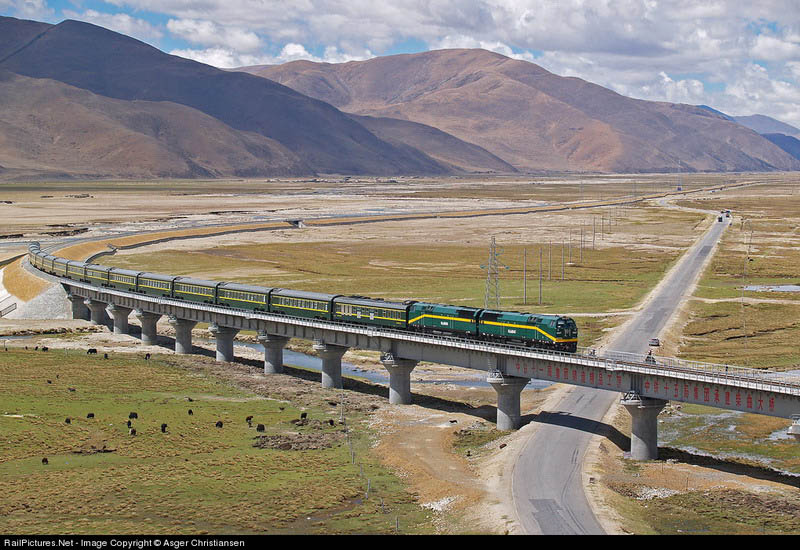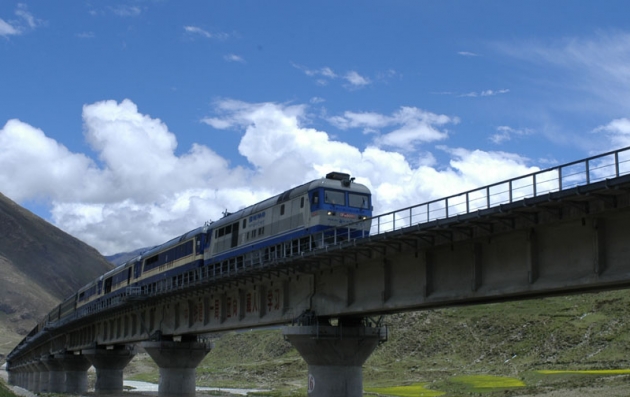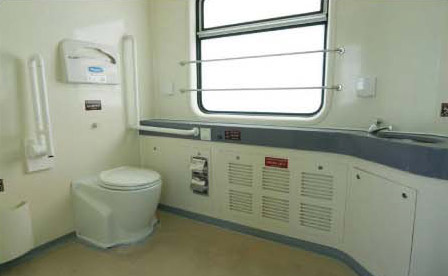Introduction
Introduction
On July 1, 2006, Ch ina's President Hu Jintao was at newly renovated Golmud Train Station cutting the red ribbon for the launch of the first train to Lhasa and declared another magnificent feat made by the Chinese people after completion of the Three Gorge Dam. Construction started on June 29th,2001,after 4 years hard work , RMB33 billion (US$4.2 billion) project (second phase) was cost, challenged the inclemency of nature ,but finally with the finish of this stand out project, proclaiming the end of no train whistling on the roof of the world.
ina's President Hu Jintao was at newly renovated Golmud Train Station cutting the red ribbon for the launch of the first train to Lhasa and declared another magnificent feat made by the Chinese people after completion of the Three Gorge Dam. Construction started on June 29th,2001,after 4 years hard work , RMB33 billion (US$4.2 billion) project (second phase) was cost, challenged the inclemency of nature ,but finally with the finish of this stand out project, proclaiming the end of no train whistling on the roof of the world.
The Qinghai-Tibet railway boasts 960 km track located 4,000 meters (12,000 feet) above sea level and the highest point at 5,072 meters (15,220 feet). The rail is dubbed "Sky Track" as many international experts hardly believe the people can build a railway in such a challenging area. But Chinese people made it come true, which open the "sky way " to the holy roof of the world.
dubbed "Sky Track" as many international experts hardly believe the people can build a railway in such a challenging area. But Chinese people made it come true, which open the "sky way " to the holy roof of the world.
The Qinghai-Tibet railway is totally 1,956 kilometers (1216 miles) long, consisting of 2 phases: the first phase 814 km (506 miles) from Xinning - the capital of Qinghai Province to Golmud opened in 1984; the second phase 1142 km (710 miles) from Golmud to Lhasa. In the following years, the Chinese government is going to extend the railroad to Shigatse (about 300 km west of Lhasa) and Linzhi regions (about 400 km east of Lhasa).

Environmental Protection
The environmental impact of the new Qinghai-Tibet railway is an ongoing concern. The increase in passenger traffic will result in greater tourism and economic activity on the Tibetan Platea.
Dejectas and junks are collected into two vacuum containers in every car and not chucked on the tracks. They are taken out after arriving at the terminus.
 Wood is the main fuel source for rural inhabitants in certain regions of Tibet. The damage to the ecosystem caused by cutting trees for fuel takes years to recover due to slow growth caused by Tibet's harsh environmental conditions. The Qinghai-Tibet railway would make coal, which is not produced in Tibet, an affordable replacement. However, the increase in fuel combustion due to increased human activity in an already-thin atmosphere may affect the long term health of the local population.
Wood is the main fuel source for rural inhabitants in certain regions of Tibet. The damage to the ecosystem caused by cutting trees for fuel takes years to recover due to slow growth caused by Tibet's harsh environmental conditions. The Qinghai-Tibet railway would make coal, which is not produced in Tibet, an affordable replacement. However, the increase in fuel combustion due to increased human activity in an already-thin atmosphere may affect the long term health of the local population.
For tourists, riding a train to Tibet is an opportunity not to be missed. Otherwise, you will miss the stunning scenery along the railway. Travellers can not help to shoot the magnificent snow-capped mountains stretching hundreds of kilometers, endless steppes, vast deserts, blue lakes and so on.


